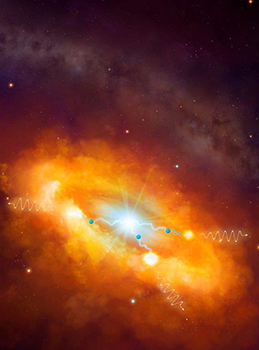Latest News Archive
Please select Category, Year, and then Month to display items
17 May 2024
|
Story Anthony Mthembu
|
Photo Supplied
 Prof Magdalena Sobon from Poland and Michael Jackson Blebo from Ghana shared their expertise with staff and students during their visit to the Department of Fine Arts at the University of the Free State.
Prof Magdalena Sobon from Poland and Michael Jackson Blebo from Ghana shared their expertise with staff and students during their visit to the Department of Fine Arts at the University of the Free State.
In a concerted effort to solidify its identity in South Africa and abroad, the Department of Fine Arts at the University of the Free State (UFS) recently played host to two distinguished artists: Prof Magdalena Sobon from the Wladyslaw Strzeminski Academy of Fine Arts in Lodz, and the Ghanaian multidisciplinary artist, Michael Jackson Blebo.
Dr Adelheid Von Maltitz, Senior Lecturer in the Department of Fine Arts at UFS, lauded the visits, held between 19 and 29 March 2024, as an enriching learning experience for the faculty and students within the department.
The visit highlights
During their visit to UFS, Prof Sobon and Blebo actively engaged with the department’s staff and students. Prof Sobon, an acknowledged paper-making artist, conducted a comprehensive two-day workshop, imparting extensive knowledge in this craft. As a direct outcome of this workshop, the department has procured the requisite equipment and materials, enriching the students’ capabilities in this medium. Blebo on the other hand, conducted a demonstration on clay bust modelling and both artists participated in critique sessions with the fourth-year students. Dr Von Maltitz underlined the significance of Blebo’s African heritage, noting, ‘’For our students to interact with a young, accomplished artist of his calibre is of benefit to them in terms of how they may envision their art careers.’’ Of particular note were Prof Sobon’s interactions with the students, wherein she shared her own artistic practices from her student years during her lectures.
In addition to their engagements with the students, Prof Sobon and Blebo also had the opportunity to present their research to second-year sculpture students at the Richmond Land Art Project, an off-campus initiative fostering art creation centred on socio-economic and other pertinent issues.
Future collaborations
Dr Von Maltitz emphasised the importance of maintaining ties with these eminent artists for the department’s growth and global outreach. Prof Sobon’s visit has paved the way for two department members to visit the Wladyslaw Strzeminski Academy of Fine Arts in Lodz in the near future. ‘’These individuals will get an opportunity to learn about studio setups and network with fellow academics, creative researchers, and artists,’’ stated Dr Von Maltitz. She hailed the visit by the two artists as both stimulating and fruitful, particularly for the students.
Two scientists part of team that discovers the source of the highest energy cosmic rays at the centre of the Milky Way
2016-03-22

Artist's impression of the giant molecular clouds surrounding the Galactic Centre, bombarded by very high energy protons accelerated in the vicinity of the central black hole and subsequently shining in gamma rays.
Artist's impression: © Dr Mark A. Garlick/ H.E.S.S. Collaboration Spotlight photo:
Dr Brian van Soelen and Prof Pieter Meintjes of the UFS Department of Physics.
Photo: Charl Devenish
|
H.E.S.S. (High Energy Stereoscopic System) scientists publically revealed their latest galactic discovery in the international science journal, Nature, on 16 March 2016. These scientists were able to pinpoint the most powerful source of cosmic radiation – which, up to now, remained a mystery.
Part of this team of scientists are Prof Pieter Meintjes and Dr Brian van Soelen, both in the University of the Free State (UFS) Department of Physics. Dr Van Soelen explains that they have discovered a proton PeVatron – a source that can accelerate protons up to energies of ~1 PeV (10^15 eV) – at the centre of the Milky Way. The supermassive black hole called Sagittarius A has been identified as the most plausible source of this unprecedented acceleration of protons.
The protons are accelerated to Very High Energy (VHE) gamma rays. The energy of these protons are 100 times larger than those achieved by the Large Hadron Collider at CERN (the European Organization for Nuclear Research).
According to Dr Van Soelen, the fact that this research has been published in Nature demonstrates the importance and pioneering nature of the research conducted by H.E.S.S. The H.E.S.S. observatory – operational in Namibia – is a collaboration between 42 scientific institutions in 12 countries.
In 2006, H.E.S.S. was awarded the Descartes Prize of the European Commission – the highest recognition for collaborative research – and in 2010 the prestigious Rossi Prize of the American Astronomical Society. The extent of the observatory’s significance places it among the ranks of the Hubble Space Telescope and the telescopes of the European Southern Observatory in Chile.
“The next generation VHE gamma-ray telescope,” Dr Van Soelen says, “will be the Cherenkov Telescope Array (CTA), which is currently in the design and development stage.” Both Dr Van Soelen and Prof Meintjes are part of this project as well.
H.E.S.S. has issued a complete statement about the paper published in Nature.